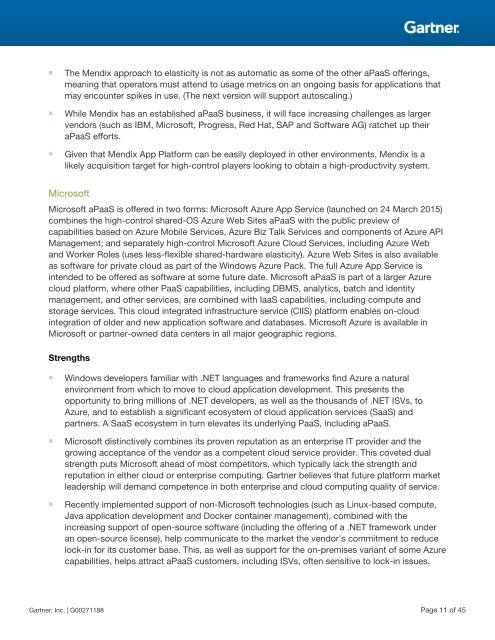Magic Quadrant for Enterprise Application Platform as a Service, Worldwide
You also want an ePaper? Increase the reach of your titles
YUMPU automatically turns print PDFs into web optimized ePapers that Google loves.
■<br />
■<br />
■<br />
The Mendix approach to el<strong>as</strong>ticity is not <strong>as</strong> automatic <strong>as</strong> some of the other aPaaS offerings,<br />
meaning that operators must attend to usage metrics on an ongoing b<strong>as</strong>is <strong>for</strong> applications that<br />
may encounter spikes in use. (The next version will support autoscaling.)<br />
While Mendix h<strong>as</strong> an established aPaaS business, it will face incre<strong>as</strong>ing challenges <strong>as</strong> larger<br />
vendors (such <strong>as</strong> IBM, Microsoft, Progress, Red Hat, SAP and Software AG) ratchet up their<br />
aPaaS ef<strong>for</strong>ts.<br />
Given that Mendix App Plat<strong>for</strong>m can be e<strong>as</strong>ily deployed in other environments, Mendix is a<br />
likely acquisition target <strong>for</strong> high-control players looking to obtain a high-productivity system.<br />
Microsoft<br />
Microsoft aPaaS is offered in two <strong>for</strong>ms: Microsoft Azure App <strong>Service</strong> (launched on 24 March 2015)<br />
combines the high-control shared-OS Azure Web Sites aPaaS with the public preview of<br />
capabilities b<strong>as</strong>ed on Azure Mobile <strong>Service</strong>s, Azure Biz Talk <strong>Service</strong>s and components of Azure API<br />
Management; and separately high-control Microsoft Azure Cloud <strong>Service</strong>s, including Azure Web<br />
and Worker Roles (uses less-flexible shared-hardware el<strong>as</strong>ticity). Azure Web Sites is also available<br />
<strong>as</strong> software <strong>for</strong> private cloud <strong>as</strong> part of the Windows Azure Pack. The full Azure App <strong>Service</strong> is<br />
intended to be offered <strong>as</strong> software at some future date. Microsoft aPaaS is part of a larger Azure<br />
cloud plat<strong>for</strong>m, where other PaaS capabilities, including DBMS, analytics, batch and identity<br />
management, and other services, are combined with IaaS capabilities, including compute and<br />
storage services. This cloud integrated infr<strong>as</strong>tructure service (CIIS) plat<strong>for</strong>m enables on-cloud<br />
integration of older and new application software and datab<strong>as</strong>es. Microsoft Azure is available in<br />
Microsoft or partner-owned data centers in all major geographic regions.<br />
Strengths<br />
■<br />
■<br />
■<br />
Windows developers familiar with .NET languages and frameworks find Azure a natural<br />
environment from which to move to cloud application development. This presents the<br />
opportunity to bring millions of .NET developers, <strong>as</strong> well <strong>as</strong> the thousands of .NET ISVs, to<br />
Azure, and to establish a significant ecosystem of cloud application services (SaaS) and<br />
partners. A SaaS ecosystem in turn elevates its underlying PaaS, including aPaaS.<br />
Microsoft distinctively combines its proven reputation <strong>as</strong> an enterprise IT provider and the<br />
growing acceptance of the vendor <strong>as</strong> a competent cloud service provider. This coveted dual<br />
strength puts Microsoft ahead of most competitors, which typically lack the strength and<br />
reputation in either cloud or enterprise computing. Gartner believes that future plat<strong>for</strong>m market<br />
leadership will demand competence in both enterprise and cloud computing quality of service.<br />
Recently implemented support of non-Microsoft technologies (such <strong>as</strong> Linux-b<strong>as</strong>ed compute,<br />
Java application development and Docker container management), combined with the<br />
incre<strong>as</strong>ing support of open-source software (including the offering of a .NET framework under<br />
an open-source license), help communicate to the market the vendor's commitment to reduce<br />
lock-in <strong>for</strong> its customer b<strong>as</strong>e. This, <strong>as</strong> well <strong>as</strong> support <strong>for</strong> the on-premises variant of some Azure<br />
capabilities, helps attract aPaaS customers, including ISVs, often sensitive to lock-in issues.<br />
Gartner, Inc. | G00271188 Page 11 of 45



